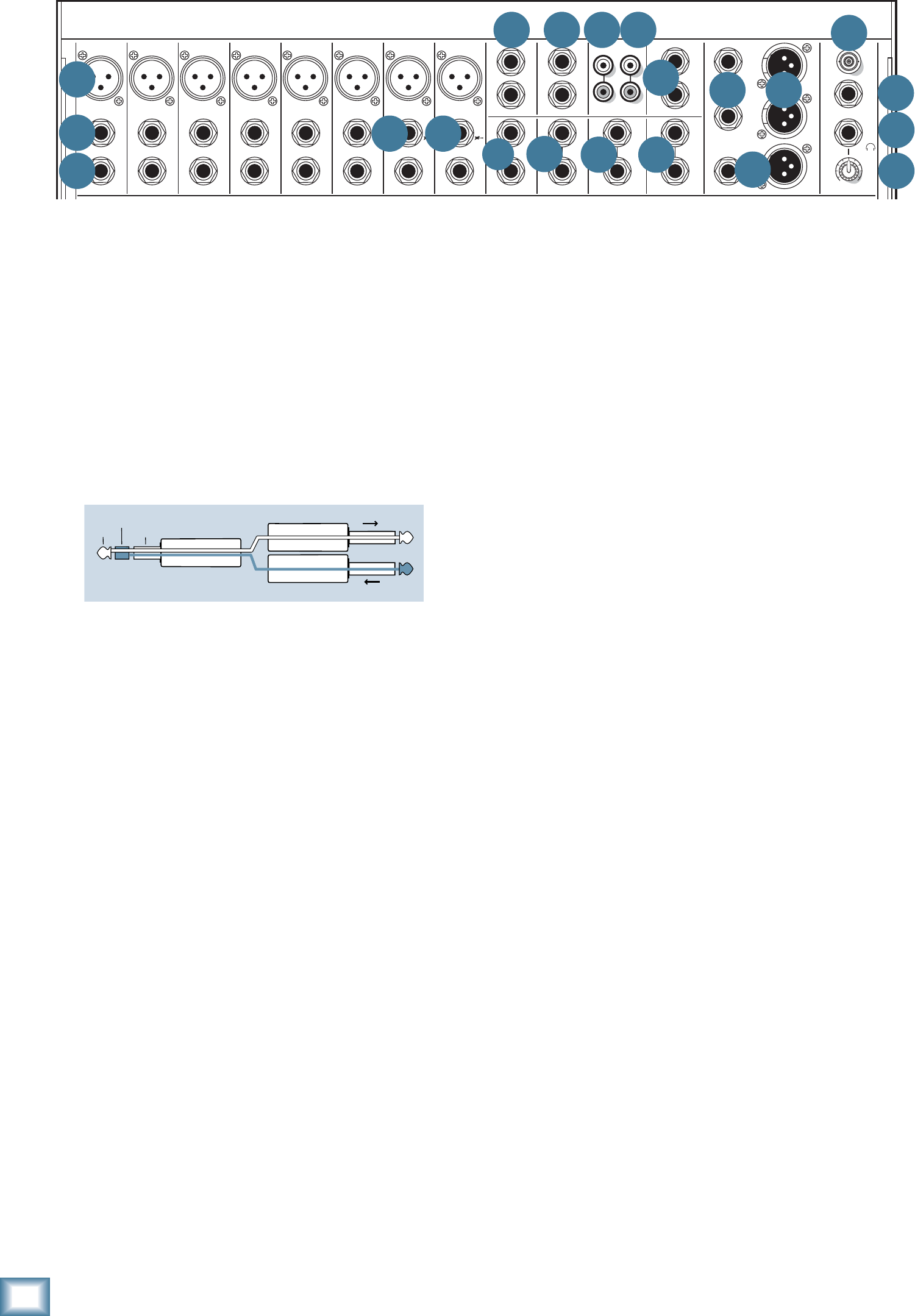
12
PPM1012
PPM1012
The monitor outputs are not affected by the main
fader [59], or the channel faders [40]. This allows you
to set up the monitor mixes and levels just right, and
not have them change every time a channel level or the
main mix level is adjusted. This is the main aim of a
monitor mix: independence from the main mix.
11. FX SEND 1 and FX SEND 2
These 1/4" TRS connectors allow you to send the FX
line-level outputs to external effects processors, while
disconnecting the internal effects processors.
FX send 1 and FX send 2 are independent of each
other, so you can set up two separate effects processors.
The FX 1 output signal is the mix of all the channels
whose FX 1 control [35] is set to more than minimum.
The FX 2 signal is the mix of all the channels whose FX
2 control [36] is set to more than minimum.
The FX outputs here do not include processed audio
from the internal effects processors. When something
is plugged into one of these outputs, the signals that
normally feed the internal effects processor are discon-
nected, and come out of these outputs instead. This
prevents you from doubling-up on effects.
Both FX outputs are affected by the channel level
faders [40]. This allows you to set up the FX level just
right, and have it follow any change made to the chan-
nel levels.
In normal use, the unprocessed (dry) mono FX sends
would go to an external effects processor. The stereo
processed (wet) output from the external effects pro-
cessor would connect to the stereo FX returns [12]. The
FX return faders [57] allow you to adjust how much of
the wet signals appear in the main mix.
9. INSERT (Ch. 1 to 8)
These unbalanced 1/4" jacks on channels 1 to 6, are
for connecting serial effects processors such as com-
pressors, equalizers, de-essers, or fi lters. The insert
point is after the gain control [23] and compressor [25]
circuits (on channels 1 – 6), but before the channel’s
EQ [27-32] and fader [40]. The channel signal can go
out of the insert jack to an external device, be processed
(or whatever) and come back in on the same insert
jack. To do this requires a special insert cable that must
be wired thusly:
Tip = send (output to effects device)
Ring = return (input from effects device)
Sleeve = common ground
Insert jacks can be used as channel direct outputs;
post-gain, and pre-EQ. See the connector section on
page 30 (fi gure G) showing three ways to use insert
cables.
10. MON SEND 1 and MON SEND 2
These 1/4" TRS connectors allow you to send the
monitor line-level output to stage monitors. These could
either be passive stage monitors powered by an external
amplifi er, or powered stage monitors with their own
amplifi er built in.
Mon send 1 and mon send 2 are independent of each
other, so you can set up two separate monitor mixes. If
you only need to set up one monitor mix, use monitor 1,
as it has its own graphic EQ [45].
The monitor 1 signal is the sum (mix) of all the
channels whose mon 1 control [33] is set to more than
minimum. The monitor 2 signal is the sum (mix) of all
the channels whose mon 2 control [34] is set to more
than minimum. The overall monitor 1 output level can
be adjusted with the mon 1 master level fader [58] and
its EQ tweaked with the monitor 1 graphic EQ [45].
“tip”
This plug connects to one of the
mixer’s Channel Insert jacks.
“ring”
tip
ring
sleeve
SEND to processor
RETURN from processor
(TRS plug)
MIC 1 MIC 2 MIC 3 MIC 4 MIC 5 MIC 6 MIC 7 MIC 8
INPUT
(BAL/UNBAL) (BAL/UNBAL) (BAL/UNBAL) (BAL/UNBAL) (BAL/UNBAL) (BAL/UNBAL) (BAL/UNBAL) (BAL/UNBAL)
INSERT INSERT INSERT INSERT INSERT INSERT INSERT INSERT
LAMP
12V 0.5A
L
R
FX SEND TAPE
OUTIN
L
MON SEND
FX RTN
(MONO)
1
2
L
R
(MONO)
L
R
(MONO)
L
R
(MONO)
1
2
FX RTN
L
R
L
R
M
L
R
M
9
12
10/
INPUT
11 12/
MAIN OUT
MAIN INSERT
FOOTSWITCH
TIP: FX1
RING: FX2
PHONES
FX
LEVEL
OO
MAX
LINELINELINELINELINELINELINE
HI-Z
LINE
HI-Z
1+
1
1+
1
R
14 13 11 10
5
9
6
7
8
8
12 12
15
16
17
21
20
18
16
7
19


















